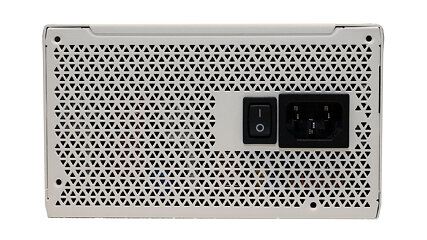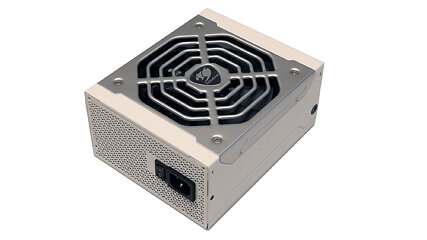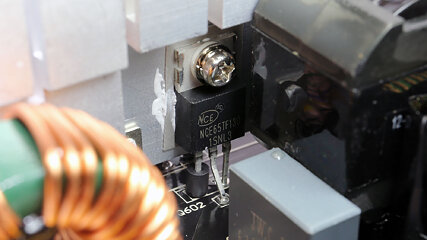 11
11
Cougar Polar 1200 W Review - Great Performance!
(11 Comments) »Introduction


Cougar's high-end Polar PSU line includes two members with 1050 and 1200 W capacities. They are rated Platinum in efficiency by 80 PLUS and Cybenetics, and Cybenetics A+ for noise output, which means their overall noise output is below 20 dBA. According to Cougar, Polar PSUs being highly efficient protects the environment, which is the case indeed. The less energy is wasted, the better for the environment, but we also have to watch overall power consumption. Over the past few years, CPU and GPU power consumption has increased, which has made PSUs of higher capacity more commonplace. If Intel, NVIDIA, and AMD don't do something to reduce the power consumption of their CPUs and GPUs, things will only get worse. Besides the environmental impact, which is the most important, electricity is becoming more expensive worldwide. You need a highly efficient PSU to at least keep energy losses under control.
Another major benefit of an efficient PSU is that it won't produce high thermal loads, so it can be cooled without using an aggressive fan-speed profile. The lower the thermal load, the lower the stress on heat-sensitive components like electrolytic capacitors. Finally, operating the fan at high speeds to cope with the thermal load is not good for longevity. It is like pushing a motor to its fullest constantly. One of the most important parts of a PSU is the cooling fan—that is, for PSUs that have one as passively cooled units do exist. If the fan dies, so does the PSU, and if there is no over-temperature protection, it will end in fireworks.
Xin Hui Yuan Tech (XHY) makes the Cougar Polar 1200 belonging to the high-end category. Besides the fully modular cable design, we find an hydraulic dynamic bearing (HDB) fan and Japanese caps everywhere, on both the primary and secondary sides. Cougar paid great attention to the details to deliver a competitive platform.
Specifications
| Features & Specifications | |
|---|---|
| Max. DC Output | 1200 W |
| PFC | Active PFC |
| Efficiency: 80 PLUS | Platinum |
| Efficiency: Cybenetics | 115 V: Platinum (89–91%) 230 V: Platinum (91–93 %) |
| Noise | Cybenetics A+ (15–20 dBA) |
| Modular | Yes (fully) |
| Intel C6/C7 Power State Support | Yes |
| Operating Temperature | 0–50°C |
| Protections | Over Voltage Protection Under Voltage Protection Over Power Protection Over Temperature Protection Over Current Protection Short Circuit Protection |
| Cooling | 135 mm hydraulic dynamic bearing fan (DWPH EFF-14E12H) |
| Semi-Passive Operation | Yes |
| Dimensions (W x H x D) | 150 x 85 x 180 mm |
| Weight | 2.21 kg (4.87 lb) |
| Compliance | ATX12V v2.52, and EPS 2.92 |
| Warranty | 10 years |
| Price at Time of Review (excl. VAT) | $300 (estimate) |
| Power Specifications | |||||||
|---|---|---|---|---|---|---|---|
| Rail | 3.3 V | 5 V | 12 V | 5 VSB | -12 V | ||
| Max. Power | 20 A | 20 A | 100 A | 3 A | 0.3 A | ||
| 100 W | 1200 W | 15 W | 3.6 W | ||||
| Total Max. Power | 1200 W | ||||||
Photos
The box is large, and at its face is a photo of the PSU with the fan grille and modular panel on display.
Protection inside the box is adequate, with packing foam surrounding the product and a bag for extra protection.
The bundle includes the modular cables and AC power cord, set of fixing bolts, Velcro strap, and user manual.
The exterior design is appealing, at least to me. The exhaust holes at the front are tiny, which restricts airflow.
Cougar's logo is stamped into both sides of the chassis. The power specifications label is at the bottom.
The modular board has 17 sockets, which will have the PSU deliver its full power smoothly.
At 180 mm long, this PSU is pretty large. However, this won't be an issue for most ATX PC cases.
Here are some more photos of the PSU from various angles.
Cables and Connectors
| Modular Cables | ||||
|---|---|---|---|---|
| Description | Cable Count | Connector Count (Total) | Gauge | In-Cable Capacitors |
| ATX connector 20+4 pin (650 mm) | 1 | 1 | 18-22AWG | No |
| 4+4 pin EPS12V (650 mm) | 1 | 1 | 16AWG | No |
| 8 pin EPS12V (650 mm) | 1 | 1 | 16AWG | No |
| 6+2 pin PCIe (650 mm) | 7 | 7 | 16AWG | No |
| 6+2 pin PCIe (650 mm+100 mm) | 1 | 2 | 16AWG | No |
| SATA (500 mm+115 mm+115 mm+115 mm) | 3 | 12 | 18AWG | No |
| 4 pin Molex (500 mm+120 mm+120 mm+120 mm) | 1 | 4 | 18AWG | No |
| AC Power Cord (1400 mm) - C13 coupler | 1 | 1 | 14AWG | - |
The ATX and EPS cables are both 650 mm long, which is adequate. Besides two EPS cables, there are seven PCIe connectors on dedicated cables and two on a single cable. As you can see, there are more than enough legacy PCIe connectors, but no 12+4 pin one. Hopefully, Cougar will provide one soon.
There are many peripheral connectors. I would like the 4-pin Molex connectors to be 150 mm apart.
The PSU came with a US power cord.
Component Analysis
Before reading this page, we strongly suggest looking at this article, which will help you better understand the insides of a PSU.| Cougar Polar 1200 Parts Description | |
|---|---|
| General Data | |
| Manufacturer (OEM) | Xin Hui Yuan Tech (XHY) |
| PCB Type | Double-sided |
| Primary Side | |
| Transient Filter | 4x Y caps, 2x X caps, 2x CM chokes, 1x MOV |
| Bridge Rectifier(s) | 2x MCC GBU15KL (800 V, 15 A @ 100°C) |
| Inrush Current Protection | NTC thermistor (MF72-5D15) (5 ohm) & relay |
| APFC MOSFETs | 2x 65R078W |
| APFC Boost Diode | 1x G3S06510A |
| Bulk Cap(s) | 2x Nippon Chemi-Con (450 V, 560 uF each or 1120 uF combined, 2,000 h @ 105°C, KMW) |
| Main Switchers | 4x NCE Power NCE65TF130 (650 V, 18 A @ 100°C, Rds (on): 0.13 ohm) |
| APFC Controller | Champion CM6500UNX |
| Switching Controller | Champion CM6901T6X |
| Topology | Primary Side: APFC, full-Bridge & LLC converter Secondary Side: synchronous rectification & DC-DC converters |
| Secondary Side | |
| +12 V MOSFETs | 8x Infineon BSC010N04LS (40 V, 178 A @ 100°C, Rds (on): 1 mOhm) |
| +5 V & +3.3 V | DC-DC Converters: 6x Excelliance MOS EMB04N03H (30 V, 45 A @ 100°C, Rds (on): 4 mOhm) PWM Controller(s): uPI-Semi uP3861P |
| Filtering Capacitors | Electrolytic: 4x Nippon Chemi-Con (105°C, W) 14x Nippon Chemi-Con (4–10,000 h @ 105°C, KY) Polymer: 9x FPCAP 4x Elite 8x no information available |
| Supervisor IC | IN1S4241-SDG |
| Fan Model | DWPH EFF-14E12H (140 mm, 12 V, 0.30 A, hydraulic bearing fan) |
| 5VSB Circuit | |
| Rectifier(s) | 60R10S SBR |
| Standby PWM Controller | Excelliance MOS Corp EM8569C |
The platform looks nice. The heatsink leaning on the bridge rectifiers is not Cougar's fault. I did it to identify the bridge rectifier model numbers and forgot to straighten it out before I took the photos. Build quality is high, and the large PCB helps with airflow. The OEM used a full-bridge topology and an LLC resonant converter on the primary side. We meet a synchronous rectification scheme for +12 V and a pair of DC-DC converters for the minor rails on the secondary side.
The transient filter has all necessary components, including an MOV.
The NTC thermistor protects against large inrush currents and is supported by a bypass relay.
The two bridge rectifiers can handle up to 30 A combined.
The APFC converter uses two 65R078W FETs and a single G3S06510A boost diode. The bulk caps are by Chemi-Con, and their combined capacity is 1120 uF.
The APFC controller is a Champion CM6500UNX.
The four NCE Power primary switching FETs are installed in a full-bridge topology.
The resonant controller is a Champion CM6901T6X.
The main transformer is next to the parts for the LLC resonant controller.
Eight Infineon FETs regulate the +12 V rail. They are installed on the solder side of the PCB.
The electrolytic caps on the secondary side are by Nippon Chemi-Con, and most of them belong to the high-end KY line. Many polymer caps are also used for ripple-filtering purposes.
Two DC-DC converters generate the minor rails.
The standby PWM controller is an EM8569C IC, and one of the 5VSB rectifiers is a 60R10S SBR.
The supervisor controller is an IN1S4241-SDG.
Several polymer and electrolytic caps installed on the main PCB reduce ripple further.
Soldering quality is good!
We usually find a Hong Hua fan on mid and high-end units, but the OEM chose DWPH. According to specifications, the fan uses a hydraulic dynamic bearing, so I expect it to be good.
Test Setup

Our Patreon Silver Supporters can read articles in single-page format.
Mar 31st, 2025 20:56 EDT
change timezone
Latest GPU Drivers
New Forum Posts
- Using V/F point only instead of combining it with offset voltage? (3)
- Can you guess Which game it is? (40)
- Msi Vector 16HX Undervolt (1)
- The TPU UK Clubhouse (26026)
- Build complete! Any thoughts on undervolting? (19)
- Technical Issues - TPU Main Site & Forum (2025) (86)
- Stuttering and frame drops when watching 4K videos (windowed only) (0)
- Help with System Recommendations (3)
- 3D Printer Club (463)
- RX 9070 availability (247)
Popular Reviews
- Sapphire Radeon RX 9070 XT Pulse Review
- ASRock Phantom Gaming B850 Riptide Wi-Fi Review - Amazing Price/Performance
- DDR5 CUDIMM Explained & Benched - The New Memory Standard
- Palit GeForce RTX 5070 GamingPro OC Review
- Samsung 9100 Pro 2 TB Review - The Best Gen 5 SSD
- Enermax REVOLUTION D.F. 12 850 W Review
- SilverStone Lucid 04 Review
- Sapphire Radeon RX 9070 XT Nitro+ Review - Beating NVIDIA
- Assassin's Creed Shadows Performance Benchmark Review - 30 GPUs Compared
- AMD Ryzen 7 9800X3D Review - The Best Gaming Processor
Controversial News Posts
- MSI Doesn't Plan Radeon RX 9000 Series GPUs, Skips AMD RDNA 4 Generation Entirely (142)
- Microsoft Introduces Copilot for Gaming (124)
- AMD Radeon RX 9070 XT Reportedly Outperforms RTX 5080 Through Undervolting (119)
- NVIDIA Reportedly Prepares GeForce RTX 5060 and RTX 5060 Ti Unveil Tomorrow (115)
- Over 200,000 Sold Radeon RX 9070 and RX 9070 XT GPUs? AMD Says No Number was Given (100)
- NVIDIA GeForce RTX 5050, RTX 5060, and RTX 5060 Ti Specifications Leak (96)
- Retailers Anticipate Increased Radeon RX 9070 Series Prices, After Initial Shipments of "MSRP" Models (90)
- China Develops Domestic EUV Tool, ASML Monopoly in Trouble (88)


































































